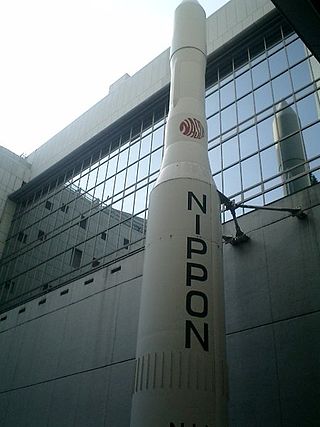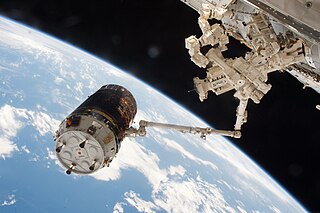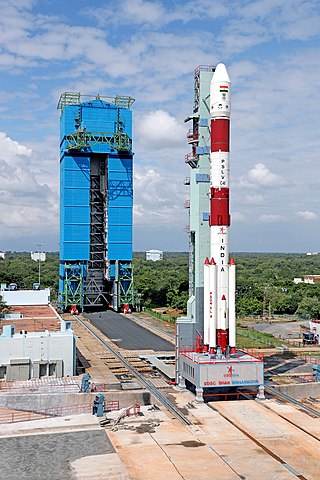Related Research Articles

Hayabusa was a robotic spacecraft developed by the Japan Aerospace Exploration Agency (JAXA) to return a sample of material from a small near-Earth asteroid named 25143 Itokawa to Earth for further analysis. Hayabusa, formerly known as MUSES-C for Mu Space Engineering Spacecraft C, was launched on 9 May 2003 and rendezvoused with Itokawa in mid-September 2005. After arriving at Itokawa, Hayabusa studied the asteroid's shape, spin, topography, color, composition, density, and history. In November 2005, it landed on the asteroid and collected samples in the form of tiny grains of asteroidal material, which were returned to Earth aboard the spacecraft on 13 June 2010.

The Japan Aerospace Exploration Agency (JAXA) is the Japanese national air and space agency. Through the merger of three previously independent organizations, JAXA was formed on 1 October 2003. JAXA is responsible for research, technology development and launch of satellites into orbit, and is involved in many more advanced missions such as asteroid exploration and possible human exploration of the Moon. Its motto is One JAXA and its corporate slogan is Explore to Realize.

The Tanegashima Space Center (TNSC) is the largest rocket-launch complex in Japan with a total area of about 9.7 square kilometers. It is located on the southeast coast of Tanegashima, an island approximately 40 kilometers (25 mi) south of Kyushu. It was established in 1969 when the National Space Development Agency of Japan (NASDA) was formed, and is now run by JAXA.
Institute of Space and Astronautical Science, or ISAS, is a Japanese national research organization of astrophysics using rockets, astronomical satellites and interplanetary probes which played a major role in Japan's space development. Since 2003, it is a division of Japan Aerospace Exploration Agency (JAXA).

Greenhouse Gases Observing Satellite (GOSAT), also known as Ibuki, is an Earth observation satellite and the world's first satellite dedicated to greenhouse gas monitoring. It measures the densities of carbon dioxide and methane from 56,000 locations on the Earth's atmosphere. The GOSAT was developed by the Japan Aerospace Exploration Agency (JAXA) and launched on 23 January 2009, from the Tanegashima Space Center. Japan's Ministry of the Environment, and the National Institute for Environmental Studies (NIES) use the data to track gases causing the greenhouse effect, and share the data with NASA and other international scientific organizations.

Guangde Rocket Launch Site also known as Base 603 (603基地) is a suborbital launch site that was operated by the Chinese Academy of Sciences located in Shijiedu (誓节渡), Shijie Town (誓节镇), Guangde County, Xuancheng Prefecture, Anhui province on the Chinese east coast.

The N-I or N-1 was a derivative of the American Thor-Delta rocket, produced under license in Japan. The N stood for "Nippon" (Japan). It used a Long Tank Thor first stage, a Mitsubishi Heavy Industries-designed LE-3 engine on the second stage, and three Castor SRMs. Seven were launched between 1975 and 1982, before it was replaced by the N-II. Six of the seven launches were successful, however on the fifth flight, there was recontact between the satellite and the third stage, which caused the satellite to fail.
The Institute for Unmanned Space Experiment Free Flyer (USEF) (財団法人無人宇宙実験システム研究開発機構) was a Japanese space agency, which was founded by the Ministry of International Trade and Industry in 1986. Unlike NASDA, ISAS, and NAL, it was not included in the JAXA organization, which was founded in 2003. The chairperson is Ichiro Taniguchi.

Kounotori 6 (こうのとり6号機), also known as HTV-6, was the sixth flight of the H-II Transfer Vehicle, an uncrewed cargo spacecraft launched to resupply the International Space Station. It was launched at 13:26:47 UTC on 9 December 2016 aboard H-IIB launch vehicle from Tanegashima Space Center.
TRICOM-1R, also known as Tasuki, was a Japanese nanosatellite that was launched during the SS-520-5 sounding rocket test launch on 3 February 2018, with a mission to conduct store and forward data relay and Earth observation using a set of cameras.
The Innovative Satellite Technology Demonstration Program is a series of spacecraft missions for testing technology and ideas put forward by universities and private companies. The program demonstrates various experimental devices and technology in space by providing flight opportunities. It is managed by the JAXA Research and Development Directorate. According to JAXA, the goal of this program is to test high risk, innovative technology that will lead to the space industry gaining competitiveness in the international field.
Warpspace is a private Japanese company developing an inter-satellite communication system based on laser communication. Warpspace is developing a medium Earth orbit satellite, WarpHub InterSat, which will communicate with other satellites in low Earth orbit using optical communication, then pass on the received data to ground stations.
WARP-01, nicknamed Nichirin, was a 1U-sized CubeSat developed and operated by Warpspace, a newspace company based in Tsukuba, Japan. It was launched on 20 February 2021 on board a Cygnus cargo spacecraft, and deployed from the International Space Station (ISS) on 14 March 2021. WARP-01 was used for technology validation and monitoring the radio wave and radiation environment in space.
KITSUNE was a nanosatellite developed by the HAK consortium, which consists of Haradaseiki Kogyo, Addnics Corporation, and Kyushu Institute of Technology (Kyutech). The spacecraft was a 6U CubeSat, and carried a high-resolution camera for Earth observation. KITSUNE was carried to the International Space Station (ISS) on board Cygnus NG-17, and was deployed from the ISS's Kibō Module on 24 March 2022 12:10 UTC. The deployment service of KITSUNE was provided by Mitsui Bussan Aerospace.
Space NTK is a space funeral company providing space burial services for the cremated remains of both human and pets. The company also conducts space pre-funeral by sending part of one's body such as nails and hair to space. Space NTK was founded by Tomoko Kasai in 2017.
RAISE-3 is a smallsat for technology demonstration developed by Mitsubishi Heavy Industries (MHI). Part of the Japanese space agency JAXA's Innovative Satellite Technology Demonstration Program, RAISE-3 carried multiple technologies that were selected for in-orbit demonstration. RAISE-3 was launched on 12 October 2022 by an Epsilon rocket as the main satellite of Innovative Satellite Technology Demonstration-3, but the launch resulted in a failure and the satellite was lost.
Mitsuba was a nanosatellite developed by Kyushu Institute of Technology (Kyutech) which would have tested whether products that are not intended for use in space are still usable for satellites. Mitsuba was launched on 12 October 2022 by an Epsilon rocket, but the launch resulted in a failure and the satellite was lost.
SpaceTuna1 is a nanosatellite developed by Kindai University to test the properties of reflective materials in space.The project aims to use this technology to monitor tunas as an alternative to the use of tags for biologging. SpaceTuna1 has been launched from Wallops Flight Facility on board a Cygnus spacecraft on 7 November 2022, and will later be deployed from the International Space Station (ISS).
DigitalBlast is a Japanese aerospace consulting firm focusing on the space industry in general. It provides guidance to firms seeking to enter the space sector, along with providing support for digital transformation. The company also manages SPACE Media, a news website focusing on private spaceflight.

PSLV-C48 was a mission of the Indian Polar Satellite Launch Vehicle (PSLV) rocket, launched on Thursday, December 11, 2019, at 15:25 Hrs (IST) by the Indian Space Research Organisation (ISRO) from the second launch pad of the Satish Dhawan Space Centre at Sriharikota, Andhra Pradesh.
References
- ↑ "福岡の"リアル下町ロケット"!宇宙ベンチャー企業「QPS研究所」". RKB Online (in Japanese). June 28, 2022. Archived from the original on 2022-12-22. Retrieved 2023-12-15.
- ↑ Foust, Jeff (August 17, 2023). "Japanese SAR company iQPS to launch with Rocket Lab after Virgin Orbit bankruptcy". SpaceNews . Retrieved 2023-12-15.
- ↑ "九州から宇宙へ! 衛星開発ベンチャー「QPS研究所」の師弟の夢". FUKUOKA leap up (in Japanese). June 18, 2020. Archived from the original on 2023-03-21. Retrieved 2023-12-15.
- ↑ Werner, Debra (September 30, 2020). "Japan's iQPS to update technology for future radar satellites". SpaceNews . Archived from the original on 2023-12-15. Retrieved 2023-12-15.